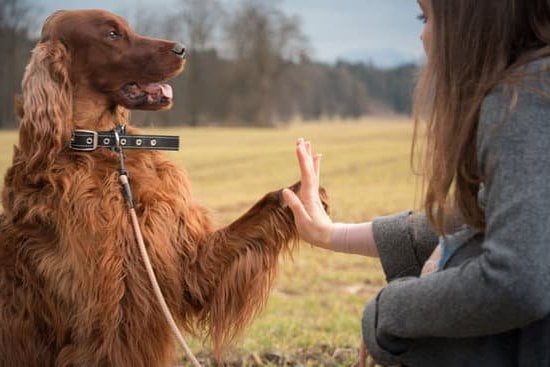Deafness in dogs can present unique challenges for both pets and their owners. In this article, we will explore how to train a deaf dog using sign language, a valuable tool that can bridge the communication gap between humans and their furry companions. By understanding the basics of deafness in dogs and learning effective training techniques, you can create a strong bond with your deaf dog and help them navigate the world confidently.
Deaf dogs rely on different cues and methods of communication compared to hearing dogs, making it essential for pet owners to adapt their training strategies accordingly. Training a deaf dog in sign language not only facilitates effective communication but also strengthens the bond between the pet and owner through positive reinforcement and mutual understanding. By utilizing visual signals rather than auditory commands, deaf dogs can easily grasp commands and feel more connected to their human companions.
In this comprehensive guide, we will delve into the benefits of training a deaf dog in sign language, providing insights into basic signs and communication techniques that are essential for successful training. Additionally, we will discuss how to create a positive training environment for your deaf dog and provide tips for overcoming challenges that may arise during the training process.
Join us as we explore the world of training deaf dogs in sign language and celebrate the remarkable bond that can be formed through effective communication strategies.
Benefits of Training a Deaf Dog in Sign Language
Deafness in dogs can present unique challenges, but training them in sign language can open up a whole new world of communication and understanding. By using visual cues instead of verbal commands, you can effectively show your deaf dog what behaviors you desire from them. This not only strengthens the bond between you and your furry friend but also allows for better obedience and comprehension.
One of the key benefits of training a deaf dog in sign language is that it helps eliminate any potential confusion that may arise from using vocal cues. Dogs rely heavily on body language and facial expressions to communicate with each other, so incorporating hand signals into their training aligns with their natural instincts. This results in a more natural and effective form of communication that can bridge the gap between you and your deaf pup.
Additionally, training a deaf dog in sign language can enhance their overall quality of life. With proper training, they can navigate the world around them with more confidence and understanding. Basic commands such as sit, stay, or come can be easily taught through repetition and positive reinforcement. As you progress to more advanced commands, you’ll find that your deaf dog is capable of learning complex tasks and behaviors just like any other canine companion.
Getting Started
Deaf dogs rely heavily on visual cues and body language to communicate, making sign language a crucial tool for effective training. When embarking on the journey of training a deaf dog using sign language, it is important to start with basic signs and communication techniques.
First and foremost, it’s essential to establish clear, consistent hand signals for common commands such as sit, stay, come, and down. Consistency is key when teaching your deaf dog sign language, so be sure to use the same hand signals each time you give a command. Additionally, positive reinforcement through treats or praise is instrumental in reinforcing good behavior and encouraging your dog to respond to the signs.
One effective technique in training a deaf dog with sign language is incorporating visual markers such as thumbs up for “good job” or thumbs down for corrections. These markers can help reinforce desired behaviors and provide clear feedback to your canine companion. It’s also beneficial to keep training sessions short and engaging to maintain your dog’s focus and enthusiasm for learning.
| Basic Sign | Description |
|---|---|
| Sit | Raise your hand palm-up from your side towards your shoulder. |
| Stay | Extend your arm outward with an open palm facing forward. |
| Come | Motion with both arms waving towards yourself. |
Creating a Positive Training Environment for Your Deaf Dog
Deaf dogs, just like hearing dogs, thrive in a positive training environment. However, since they rely on visual cues rather than auditory ones, it is important to create a space that supports their unique needs. One of the key ways to achieve this is by using sign language consistently and effectively during training sessions. This not only helps your deaf dog understand commands but also strengthens the bond between you and your furry companion.
When creating a positive training environment for your deaf dog, it is essential to use positive reinforcement techniques such as treats, praise, and toys. These rewards will help motivate and encourage your dog to learn new signs and behaviors. Additionally, maintaining a calm and patient demeanor during training sessions is crucial. Deaf dogs may take longer to grasp certain concepts, so it’s important to be consistent and understanding throughout the training process.
Another way to create a positive training environment for your deaf dog is by minimizing distractions. Since they rely on visual cues, it’s important to eliminate any sources of noise or visual clutter that could interfere with communication.
By providing a quiet and focused space for training, you can help your deaf dog stay engaged and attentive during learning sessions. With patience, consistency, and positivity, you can create an environment that promotes successful sign language training for your deaf dog.
Overcoming Challenges
Training a deaf dog in sign language can present some unique challenges, but with the right approach and techniques, it is definitely possible to overcome them. One of the key tips for training a deaf dog is to use visual cues and signals consistently.
This means being clear and deliberate in your hand gestures, facial expressions, and body language when communicating with your deaf canine companion. By establishing a consistent set of signs for commands and cues, you can help your dog understand what is expected of them.
Another important tip is to utilize positive reinforcement during training sessions. Deaf dogs, like hearing dogs, respond well to rewards such as treats, praise, or playtime. By rewarding your deaf dog for following commands correctly or exhibiting desired behaviors, you can reinforce their understanding of the sign language signals you are using. Positive reinforcement not only helps with training but also strengthens the bond between you and your furry friend.
Patience is also crucial when training a deaf dog in sign language. Remember that learning a new language takes time, so be patient with your dog as they navigate this new form of communication. It’s important to keep training sessions short and enjoyable to prevent both you and your dog from becoming frustrated. Consistent practice and patience will ultimately lead to success in teaching your deaf dog how to understand and respond to sign language commands effectively.
Advanced Sign Language Commands for Deaf Dogs
Training a deaf dog in sign language can open up a world of possibilities for communication and bonding. Once your deaf dog has mastered the basic signs and communication techniques, you can move on to teaching them more advanced commands. Here are some advanced sign language commands that you can incorporate into your training routine:
- Recall: Teaching your deaf dog to come when called is crucial for their safety. Use a consistent hand signal, such as waving both hands above your head, and pair it with a treat or reward when they respond appropriately.
- Stay: Teaching your deaf dog to stay in place can be helpful in various situations. Hold out one hand with an open palm in front of their face while using a verbal cue like “stay” or “wait.” Gradually increase the duration of the stay before rewarding them.
- Heel: Training your deaf dog to walk politely on a leash beside you can make walks more enjoyable for both of you. Use a hand signal, such as patting the side of your leg, to indicate where you want them to position themselves while walking.
These advanced sign language commands require patience, consistency, and positive reinforcement to effectively communicate with your deaf dog. Remember that each dog learns at their own pace, so be sure to tailor your training approach to suit their individual needs and abilities.
By expanding your deaf dog’s sign language vocabulary with advanced commands, you not only enhance their obedience skills but also strengthen the bond between you and your canine companion through clear and effective communication. With dedication and perseverance, you can continue to build on the foundation of basic signs and create a harmonious relationship based on trust and mutual understanding.
Incorporating Hand Signals Into Everyday Life With Your Deaf Dog
Deaf dogs rely heavily on visual cues to communicate and understand commands, making incorporating hand signals into their daily routine essential for effective communication. By using sign language to train your deaf dog, you can create a strong bond built on trust and understanding. Here are some tips on how to seamlessly integrate hand signals into everyday life with your furry companion:
- Consistency is key: When training your deaf dog with sign language, it’s crucial to be consistent with the signals you use for each command. This will help avoid confusion and ensure that your dog can easily understand what you’re asking of them.
- Start with basic commands: Begin by teaching your deaf dog simple hand signals for basic commands such as sit, stay, come, and lie down. Be patient and use positive reinforcement techniques like treats and praise to encourage good behavior.
- Practice regularly: Repetition is important when training a deaf dog in sign language. Set aside time each day to work on commands and practice communication through hand signals. This consistency will help reinforce the signals in your dog’s memory.
Advanced Hand Signals for Deaf Dogs
Once your deaf dog has mastered the basics, you can introduce more advanced hand signals to expand their repertoire of commands. Some examples of advanced hand signals include:
- Shake hands: Extend your hand palm-up towards your dog, signaling them to lift their paw and place it in your hand.
- Roll over: Use a sweeping motion with one hand down towards the ground, encouraging your dog to roll onto their back.
- Speak: Move one finger up to touch your closed lips, indicating for your dog to bark or make noise as needed.
By incorporating these advanced hand signals into everyday life activities like playtime or walks, you can deepen the communication bond between you and your deaf dog while also keeping their minds engaged through continued learning. Remember that patience, consistency, and positive reinforcement are key when training a deaf dog in sign language.
Resources for Further Training and Support
Training Classes for Deaf Dogs
For deaf dog owners looking to further their training skills and expand their knowledge of how to train a deaf dog sign language, attending specialized training classes can be incredibly beneficial. Look for trainers or organizations that specifically focus on training deaf dogs using sign language.
These classes can provide valuable insights, tips, and techniques that are tailored to the unique needs of deaf dogs. Additionally, being in a group setting with other deaf dog owners can provide a supportive community and a safe space to share experiences and resources.
Online Resources and Videos
In this digital age, there is no shortage of online resources available to help you navigate the world of training a deaf dog in sign language. Websites, forums, and social media groups dedicated to deaf dog training can offer a wealth of information, from basic sign language commands to advanced training tips.
Many trainers also share instructional videos demonstrating how to effectively communicate with your deaf dog using hand signals. These resources can be accessed anytime, anywhere, making them convenient options for busy pet parents.
Consulting With Professional Trainers
If you find yourself facing specific challenges or struggles when training your deaf dog in sign language, don’t hesitate to seek help from professional trainers who specialize in working with deaf dogs. A professional trainer can evaluate your current training methods, offer personalized guidance and solutions tailored to your dog’s individual needs, and help you fine-tune your communication skills.
Investing in a few sessions with a qualified trainer can make a significant difference in your ability to effectively train and bond with your deaf furry companion.
By utilizing these resources for further training and support, you can enhance your journey of learning how to train a deaf dog sign language while providing your furry friend with the tools they need to thrive in their unique world of silent communication.
Remember that patience, consistency, and positive reinforcement are key components of successful training with deaf dogs – and having access to valuable resources can empower you as an owner to build a strong bond with your beloved pet through the power of sign language communication.
Success Stories
Deaf dogs, like all pets, have the ability to adapt and thrive with the right training and care. Many owners of deaf dogs have successfully trained their pets using sign language communication, resulting in stronger bonds and deeper understanding between them. By incorporating hand signals into everyday interactions, deaf dogs can live fulfilling lives and even excel in various activities.
Training Success Stories
One remarkable success story is that of Max, a deaf Australian Shepherd mix who was rescued from a shelter. Despite his hearing impairment, Max quickly learned basic commands such as sit, stay, and come using sign language. With consistency and patience from his dedicated owner, Max went on to participate in agility competitions and even earned several ribbons. His story demonstrates how deaf dogs can overcome their challenges with the right training approach.
Another inspiring example is Luna, a deaf Dalmatian who was adopted as a puppy by a family willing to learn how to train her using sign language. Through positive reinforcement techniques and clear hand signals for commands like shake, lie down, and roll over, Luna blossomed into a well-behaved and responsive companion. Their journey showcases the power of communication through sign language in strengthening the bond between a deaf dog and their owner.
Community Support
In addition to individual success stories, there are numerous support groups and resources available for owners looking to train their deaf dogs in sign language. Online forums, workshops, and training classes specifically catered to deaf dogs provide valuable guidance and tips on effective communication strategies.
These communities serve as a source of encouragement and advice for owners navigating the unique challenges of training a deaf dog. By sharing experiences and knowledge within these networks, pet parents can access a wealth of information on how to train a deaf dog in sign language effectively.
Conclusion
Training a deaf dog in sign language can be an incredibly rewarding experience for both the pet and their owner. The bond that forms through this unique form of communication is truly special, fostering a deep understanding and connection between the two. By prioritizing patience, consistency, and positive reinforcement, owners can successfully train their deaf dogs to understand and respond to various hand signals.
When embarking on the journey of training a deaf dog in sign language, it is essential to remember that every pup is unique and may require different approaches. By starting with basic signs and gradually progressing to more advanced commands, owners can build a solid foundation for effective communication with their furry companions. Additionally, creating a positive training environment filled with love, encouragement, and treats will help motivate the deaf dog to learn and engage in the training process.
As owners continue to incorporate hand signals into their everyday interactions with their deaf dogs, they will witness the incredible progress and growth that comes from effective communication. With dedication and persistence, even challenges that may arise during training can be overcome.
Remembering to celebrate small victories along the way will not only boost the dog’s confidence but also strengthen the bond between them and their owner. In conclusion, training a deaf dog in sign language is not just about teaching commands; it is about fostering a deeper connection based on trust, understanding, and love.
Frequently Asked Questions
Can You Teach a Deaf Dog Sign Language?
Teaching a deaf dog sign language is definitely possible and can be very effective. Just like teaching hearing dogs commands through voice cues, deaf dogs can learn to respond to hand signals or visual cues instead. It’s important to be patient, consistent, and use positive reinforcement when training a deaf dog in sign language.
Is It Difficult to Train a Deaf Dog?
Training a deaf dog may have its challenges, but it isn’t necessarily more difficult than training a hearing dog. The key is to adapt your training methods to accommodate the lack of auditory cues. Using visual signals, such as hand signs or light signals, along with rewards for good behavior can help make the training process successful.
How Do You Give a Deaf Dog Commands?
Giving commands to a deaf dog requires using visual cues that they can easily see and understand. Hand signals are commonly used for giving commands to deaf dogs, as they rely on gestures rather than verbal cues.
You can also incorporate other visual aids like flashlights or vibrating collars to help get the attention of your deaf dog when giving commands. Consistency and positive reinforcement are essential when communicating with a deaf dog.

Welcome to the blog! I am a professional dog trainer and have been working with dogs for many years. In this blog, I will be discussing various topics related to dog training, including tips, tricks, and advice. I hope you find this information helpful and informative. Thanks for reading!





